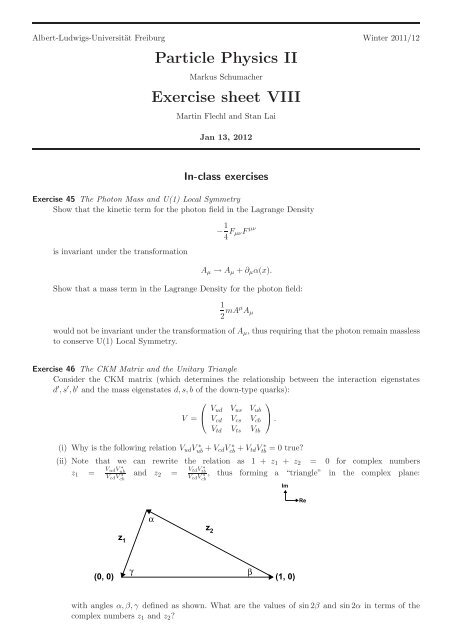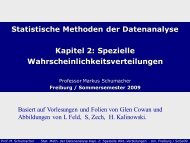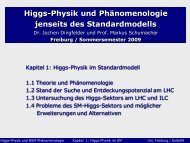Particle Physics II Exercise sheet VIII - Albert-Ludwigs-Universität ...
Particle Physics II Exercise sheet VIII - Albert-Ludwigs-Universität ...
Particle Physics II Exercise sheet VIII - Albert-Ludwigs-Universität ...
You also want an ePaper? Increase the reach of your titles
YUMPU automatically turns print PDFs into web optimized ePapers that Google loves.
<strong>Albert</strong>-<strong>Ludwigs</strong>-<strong>Universität</strong> Freiburg Winter 2011/12<br />
<strong>Particle</strong> <strong>Physics</strong> <strong>II</strong><br />
Markus Schumacher<br />
<strong>Exercise</strong> <strong>sheet</strong> V<strong>II</strong>I<br />
Martin Flechl and Stan Lai<br />
Jan 13, 2012<br />
In-class exercises<br />
<strong>Exercise</strong> 45 The Photon Mass and U(1) Local Symmetry<br />
Show that the kinetic term for the photon field in the Lagrange Density<br />
is invariant under the transformation<br />
− 1 µν<br />
FµνF<br />
4<br />
Aµ → Aµ + ∂µα(x).<br />
Show that a mass term in the Lagrange Density for the photon field:<br />
1<br />
2 mAµ Aµ<br />
would not be invariant under the transformation of Aµ, thus requiring that the photon remain massless<br />
to conserve U(1) Local Symmetry.<br />
<strong>Exercise</strong> 46 The CKM Matrix and the Unitary Triangle<br />
Consider the CKM matrix (which determines the relationship between the interaction eigenstates<br />
d ′ ,s ′ ,b ′ and the mass eigenstates d,s,b of the down-type quarks):<br />
⎛<br />
V = ⎝<br />
Vud Vus Vub<br />
Vcd Vcs Vcb<br />
Vtd Vts Vtb<br />
(i) Why is the following relation VudV ∗ ub + VcdV<br />
∗<br />
cb + VtdV<br />
∗<br />
tb = 0 true?<br />
(ii) Note that we can rewrite the relation as 1 + z1 + z2 = 0 for complex numbers<br />
z1 = VudV ∗ ub<br />
VcdV ∗<br />
VtdV<br />
∗<br />
tb<br />
and z2 =<br />
cb<br />
VcdV ∗ , thus forming a “triangle” in the complex plane:<br />
cb<br />
Im<br />
(0, 0)<br />
z1<br />
γ<br />
α<br />
z2<br />
β<br />
⎞<br />
⎠ .<br />
(1, 0)<br />
with angles α,β,γ defined as shown. What are the values of sin 2β and sin2α in terms of the<br />
complex numbers z1 and z2?<br />
Re
(iii) Express sin 2β and sin 2α in terms of the Wolfenstein parameters A,λ,ρ,η.<br />
(see lecture notes on the Wolfenstein parametrization of the CKM matrix)<br />
(iv) What coordinates does the apex of the CKM unitary triangle have in the Re-Im plane, in terms<br />
of the Wolfenstein parameters?
Home exercises<br />
<strong>Exercise</strong> 47 Equations of Motion for the Photon Field 6 Points<br />
The free Lagrangian for the photon field is given by:<br />
Lfree = − 1 µν<br />
FµνF<br />
4<br />
where Fµν = ∂µAν − ∂νAµ is the electromagnetic field tensor.<br />
From the Euler-Lagrange equations:<br />
∂µ<br />
� �<br />
∂L<br />
−<br />
∂(∂µAν)<br />
∂L<br />
∂Aν<br />
show that the equations of motion for the photon field are:<br />
∂µF µν = 0.<br />
Show that Maxwell’s equations ∇ · � E = 0 and − ∂ � E<br />
∂t + ∇ × � B = 0 are reproduced when interpreting<br />
E i = −F 0i and ǫ ijk B k = −F ij .<br />
<strong>Exercise</strong> 48 Equations of Motion for the Scalar and Vector Fields 5 Points<br />
What are the equations of motion for the scalar field Lagrangian (with self-interaction)<br />
L = 1<br />
2 (∂µφ)(∂ µ φ) − 1<br />
2 m2 φ 2 − λ<br />
4! φ4<br />
and the Proca Lagrangian for a massive vector field<br />
L = − 1<br />
4 FµνF µν + 1<br />
2 mAµ Aµ?<br />
What does the interaction vertex look like (Feynman diagram) for the scalar field Lagrangian?<br />
<strong>Exercise</strong> 49 Transformations of Vector Bosons in Yang-Mills Theory 9 Points<br />
In Yang-Mills Theory, the required infinitesimal transformation rule for the three additional vector<br />
fields, to preserve SU(2) local symmetry can be given by:<br />
�Wµ → � �α<br />
Wµ − ∂µ<br />
g − �α × � Wµ.<br />
Note that the vector symbols do not denote a three-vector in physical space, rather denote the three<br />
vector fields � Wµ = W i µ for i = 1,2,3. Note also that �α × � Wµ = ǫ ijk α j W k µ. (The quantity g is just a<br />
real number.)<br />
(i) Show that the object ∂µWν − ∂νWµ transforms to<br />
∂µWν − ∂νWµ − �α × (∂µ � Wν − ∂ν � Wµ) + � Wν × ∂µ�α − � Wµ × ∂ν�α.<br />
(ii) For the object � Wµν = ∂µ � Wν − ∂ν � Wµ − g � Wµ × � Wν, show that the infinitesimal transformation for<br />
�Wµν is given by<br />
You can make use of the identity:<br />
�Wµν → � Wµν − �α × � Wµν<br />
�A × ( � B × � C) + � B × ( � C × � A) + � C × ( � A × � B) = 0.<br />
Note that second order terms in �α can be dropped.
(iii) Show therefore that kinematic term � Wµν � W µν of the Lagrange density for the three additional<br />
vector fields is invariant (under such infinitesimal transformations). Note that second order terms<br />
in �α can be dropped.






